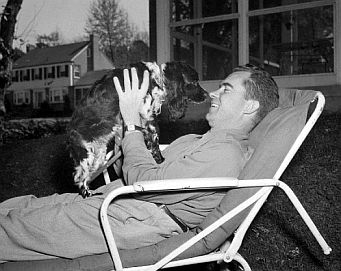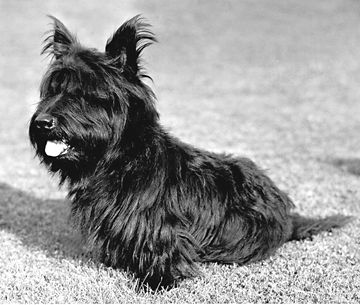When
Barney Bush entered the White House in 2001, he probably did not know that he would soon have an annual job. The holiday season at the White House brings many visitors to parties and tours to view the decorations and the historical house. Not even a year in to President George W. Bush’s administration, the United States was attacked on September 11, 2001 by terrorists. The terrorist attacks fundamentally changed many of the White House’s security procedures, including how the holiday parties and decorations were handled. After the attacks, the administration had to figure out a way to showcase the holiday decorations without jeopardizing the security of the president. The White House was closed to visitors in 2001 and special precautions were taken the next year.
It was in a staff meeting that Internet Director Jimmy Orr casually mentioned the idea of having Barney do a video from his perspective that would give people a behind-the-scenes look at the White House decorations. Orr’s idea was not taken seriously at the meeting, but afterward got around to First Lady Laura Bush. She loved the idea and told the press. After the decision was made to produce a holiday video, Mrs. Bush set strict stipulations for the video; it must be silly for kids, funny for adults, and presidential.
The president and first lady were eager to find out how many viewers had watched the Barney Cam video after it was produced. The site had more than 24 million visitors the first day Barney’s video was on the White House website, the third highest amount of traffic directed at the site. Many news stations ran the seven-minute video in its entirety. The success of the video made it an annual tradition.
Each year the White House staff had to figure out ways to improve the Barney Cam video while keeping to Mrs. Bush’s requirements. Each year many familiar Washington faces and celebrities made cameo appearances. Subtle messages were also often included in the Christmas video to promote some of Mrs. Bush’s causes or make reference to political issues. The 2005 video, “
A Very Beazley Christmas,” features a very upset Barney about the arrival and popularity of his new sister
Miss Beazley. The wife of the vice president, Lynne Cheney, talks with Barney about his poll numbers in the presidential pets poll dropping. “Remember, poll numbers are just a snapshot in time,” she said in direct reference to the decline in the president’s poll numbers. In another scene, Barney walks into the library and passed a few carefully placed children’s books to reference the importance of literacy. The 2007 version of Barney Cam was titled, “
Holiday in the National Parks,” and was also the theme of the White House Christmas decorations. That year, the Bush’s were highlighting the significance of the National Parks after the president announced a plan to invest more than $1 billion in the parks over the next decade. The president’s daughters, Barbara and Jenna Bush, talked to Barney and Miss Beazley about how important the National Parks are to the country. Mrs. Bush and National Parks Director Mary Bomar talked to Barney and Miss Beazley about becoming Junior Park Rangers and how they can help the National Parks.
The White House produced the annual holiday video every year until the end of Bush’s term. Even though the original intent of the video was to showcase the holiday decorations, it became a way to communicate with an audience that would not normally visit the White House website or that did not like the president. It showed viewers that the Bush’s and the White House staff were real people and could poke fun at their own situations.
Click
here to see Barney's archived website.





 On their return trip from Hawaii, President Roosevelt and Fala stopped to visit the Aleutian Islands. Their secret stop at Adak Island became highly scrutinized. A rumor was started that Fala had been accidently left behind on another island and the president sent at Navy destroyer ship back to get Fala for a cost of $20,000 at the taxpayers’ expense. The event became highly publicized during the 1944 presidential campaign and Republicans accused the president of spending millions of taxpayer dollars to fetch the little dog. The president confronted the allegations and defended his little dog during a campaign dinner speech to the International Brotherhood Teamsters Union, which was supposed to be an update on labor issues and the war, but became famously known as the “Fala Speech”:
On their return trip from Hawaii, President Roosevelt and Fala stopped to visit the Aleutian Islands. Their secret stop at Adak Island became highly scrutinized. A rumor was started that Fala had been accidently left behind on another island and the president sent at Navy destroyer ship back to get Fala for a cost of $20,000 at the taxpayers’ expense. The event became highly publicized during the 1944 presidential campaign and Republicans accused the president of spending millions of taxpayer dollars to fetch the little dog. The president confronted the allegations and defended his little dog during a campaign dinner speech to the International Brotherhood Teamsters Union, which was supposed to be an update on labor issues and the war, but became famously known as the “Fala Speech”:




 I've always loved animals and have had pets, but it wasn't until recently when I started researching for a graduate school class, did I realize how often pets are involved in and often shape politics. Many of my classmates didn't take my research seriously until I gave my final presentation and then they were amazed at my findings.
I've always loved animals and have had pets, but it wasn't until recently when I started researching for a graduate school class, did I realize how often pets are involved in and often shape politics. Many of my classmates didn't take my research seriously until I gave my final presentation and then they were amazed at my findings.